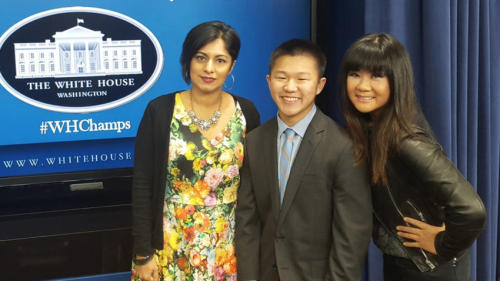#apahm2016
“Some people aren’t going to know they’ll miss us until we’re gone.”
– Michael Komai, publisher of Rafu Shimpo
For 113 years, the Rafu Shimpo newspaper has endured. It has devotedly told the story of the Japanese American community in Southern California.
It even survived World War II, despite its writers and editors being forced into incarceration camps. Eldest son Akira Komai took over the paper when his father, Toyosaku Komai, was arrested by the FBI with others labeled “enemy aliens” hours after Japanese planes bombed Pearl Harbor. Just before he, too, was forced to go, Akira hid the newspaper’s Japanese lead type in hopes that the Rafu could one day restart.

Below, you can see the last issue published before they left. There’s a letter to readers on the front page in that April 4, 1942 issue, headlined, “We’ll meet again.” On Jan. 1, 1946, the paper resumed publishing.

Now, there’s one force it might not survive: the economy.
The paper has lost $750,000 over the last three years, and it’s expected to lose $350,000 this year.
Now if the paper doesn’t raise about $500,000 in revenue — by more than doubling its subscribers — it could close in December. This would be the end of one of the last English-Japanese dailies in the U.S. – and the oldest. Rafu Shimpo which literally means Los Angeles newspaper, started in 1903 as a mimeographed sheet put together by three USC students.
To this day, only the Rafu covers every single summer Obon festival, the annual Nisei Week celebration in Little Tokyo, and numerous community events from awards dinners to bazaars. It marks the triumphs and transitions of Japanese Americans in our area, from graduations to deaths.

“Those kind of successes in the community are only going to be here,” said Gwen Muranaka, the paper’s English editor-in-chief.
Times’ reporter Samantha Masunaga recently wrote about the paper’s plight. You can learn more about the community’s response so far and see other front pages in her story.
Photos by Los Angeles Times
Post link
”One of the biggest tools for getting people ‘woke’ is art. You can move people with art, and once you move them, you can create consciousness, and change. You can’t just tell people to register to vote and be done with it.”
– Tanzila “Taz” Ahmed, an activist and host of the Good Muslim Bad Muslim podcast
These three Angelenos were among 10 people the White House honored as “Champions of Change for Asian American and Pacific Islander Art and Storytelling.” With Taz are Jason Fong, a high school student and creator of the #MyAsianAmericanStory hashtag, and Jenny Yang, a writer and stand-up comedian.
@dex spoke with them recently about comedy, community, the impact of whitewashing in Hollywood, the Peter Liang trial and other timely topics. You can check that out here.
Photo by Jenny Yang
Post link



